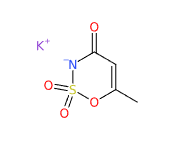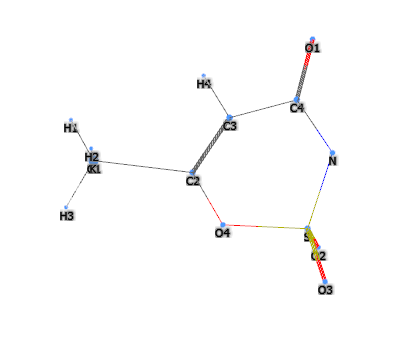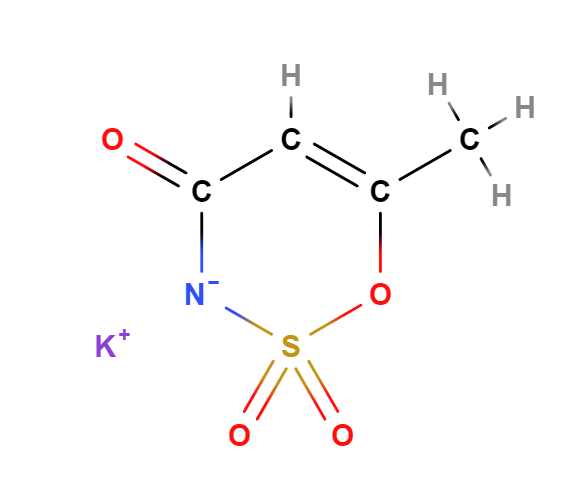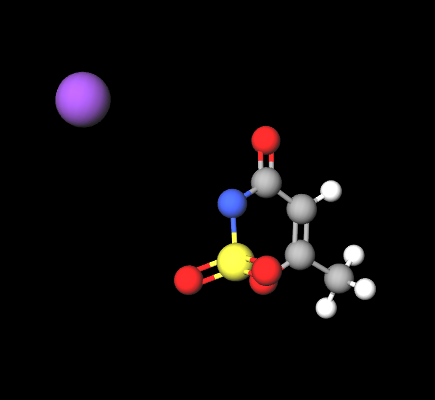Acesulfame K is a chemical compound, derived from sulphuric acid, the potassium salt of acesulfame (6-methyl-1,2,3-oxathiazine-4(3H)-one 2,2-dioxide), which belongs to the class of sulphonamides or sulfonamides of which it is an acid cyclic. Sulphonamides are chemically produced antibacterial drugs.
Acesulfame K, also known as Acesulfame Potassium, is a calorie-free sugar substitute (artificial sweetener), and is often used in combination with other sweeteners.
The name "Acesulfame K" provides information about the nature of the compound:
- "Acesulfame" is derived from acetoacetic acid. The compound contains a sulfonyl group (a sulfur atom bound to two oxygen atoms and a carbon atom), which is responsible for its sweet taste.
- "K" is the symbol of potassium on the periodic table of elements. In the case of Acesulfame K, a potassium atom is used to stabilize the negative charge on the oxygen atom after the sulfur has formed a bond with the nitrogen atom.
The synthesis process takes place in several stages:
- Synthesis of the precursor. The first phase begins with the synthesis of acetoacetic acid using diketene and formaldehyde.
- Sulphonation. Acetoacetic acid is sulfonated using Sulfamic acid to produce 2,2-1,3-oxathiazin-4 (3H) -one 2,2-6-methyl dioxide, which is acesulfame K.
- Conversion to potassium salt. The final step is to convert acesulfame to its potassium salt, acesulfame K. This is typically achieved by reacting acesulfame with potassium hydroxide.
It appears as a white crystalline powder easily soluble in water, slightly soluble in ethanol.
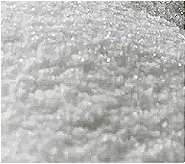
What it is used for and where
Food
Ingredient included in the list of European food additives as E950 as a sweetener.
Acesulfame K is one of the most widely used low-calorie artificial sweeteners replacing sugar, about 200 times sweeter and belongs to the non-nutritive sweeteners (NNS). It is labelled with the number E950 in the list of European food additives as a sweetener.
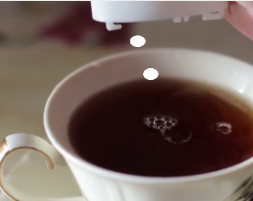
High-intensity sweeteners are believed to be potential organic contaminants due to their widespread use in foods, drugs and healthcare products. They are introduced into the environment by different paths and are introduced into the waters (1).
The cause of the pollution is the extreme persistence resistant to water treatment processes for the continuous introduction in the aquatic environments, in particular for the Acesulfame present above all in winter (2).

Regarding human health, Acesulfame has been (2014) tested in concentrations equal to those found in non-alcoholic drinks, but, at least in this study, no interference has been found on the aryl receptor and on the glucocorticoid receptor. (3).
However, an ADI or Admissible Daily Dose of 15 mg/kg of body weight is provided. In this study, however, unlike Sucralose, another sweetener, Acesulfame K, at the maximum levels of DGA, did not influence the relative amount of Clostridium XIVa cluster in the metabolism of fecal microbes and cholesterol in laboratory animals (4) .
Pregnant and lactating women, children, diabetics and epilepsy patients represent the susceptible population to the adverse effects of Nonnutritive sweeteners (NNS) containing products and should use these products with utmost caution. The overall use of NNS remains controversial, and consumers should be amply informed about the potential risks of using them, based on current evidence-based dietary guidelines.
An 11–12 years follow-up study in the UK showed that consuming 2 or more servings of NNS-containing diet soft drinks increased the risk of coronary heart disease and chronic kidney disease in comparison with consuming.
Recent studies have suggested that this artificial sweetener may cause undesirable effects to the intestinal mucosa (6).
Cosmetics
Fragrance. It plays a decisive and important role in the formulation of cosmetic products as it provides the possibility of enhancing, masking or adding fragrance to the final product, increasing its marketability. It is able to create a perceptible pleasant odour, masking a bad smell. The consumer always expects to find a pleasant or distinctive scent in a cosmetic product.
For more information:
Acesulfame K studies
Typical commercial product characteristics Acesulfame potassium
| Appearance | White crystalline solid |
| pH | 5.5-7.5 |
| Boiling Point | 332.7ºC at 760 mmHg |
| Melting Point | 229-232°C |
| Flash Point | 155ºC |
| Density | 1.512g/cm3 |
| LogP | 0.47680 |
| PSA | 68.82000 |
Loss on Drying
| ≤1% at 105°C |
| Ultraviolet Absorption | 227±2nm |
Organic Impurities
| ≤20 μg/g |
Heavy Metals
| ≤5 mg/kg |
| As | ≤3 mg/kg |
| Pb | ≤1 mg/kg |
| Selenium | ≤10 mg/kg |
| Fluoride | ≤3 mg/kg |
Particle Size
| 30-100 mesh |
| Storage | 0-6°C |
Price
1 kg $42
- Formula molecolare: C4H4KNO4S
- Peso molecolare: 201.237 g/mol
- CAS: 55589-62-3
- EC Number: 259-715-3
- UNII 23OV73Q5G9
- DSSTox Substance ID DTXSID1030606
- IUPAC potassium;6-methyl-2,2-dioxo-1-oxa-2λ6-thia-3-azanidacyclohex-5-en-4-one
- InChl=1S/C4H5NO4S.K/c1-3-2-4(6)5-10(7,8)9-3;/h2H,1H3,(H,5,6);/q;+1/p-1
- InChl Key WBZFUFAFFUEMEI-UHFFFAOYSA-M
- SMILES CC1=CC(=O)[N-]S(=O)(=O)O1.[K+]
- PubChem Substance ID 329747862
- MDL number MFCD00043833
- RTECS RP4489165
- ChEBI 184415
- Beilstein Registry Number 3637857
- NCI C76512
- RXCUI 1310545
Synonyms:
- Acesulfame potassium
- potassium 6-methyl-4-oxo-4H-1,2,3-oxathiazin-3-ide 2,2-dioxide
- 6-Methyl-1,2,3-oxathiazin-4(3H)-one 2,2-dioxide potassium salt
- Acesulfame-potassium
- Acesulfame-K
- Potassium 6-methyl-1,2,3-oxathiazin-4(3H)-one 2,2-dioxide
- Potassium 6-methyl-2,2-dioxo-1-oxa-2$l^{6}-thia-3-azanidacyclohex-5-en-4-one
- Sunnett
- Otizon
- Sunett
- Sweet One.
- E 950
- 6-methyl-3H-1,2,3-oxathiazine-2,2,4-trione, potassium salt
- Acesulfame potassium, European Pharmacopoeia (EP) Reference Standard
- 6-Methyl-3,4-dihydro-1,2,3-oxathiazin-4-one 2,2-Dioxide Potassium Salt
- potassium;6-methyl-2,2-dioxo-1-oxa-2?^{6}-thia-3-azanidacyclohex-5-en-4-one
References____________________________________________________________________
(1) Arbeláez P, Borrull F, Pocurull E, Marcé RM. Determination of high-intensity sweeteners in river water and wastewater by solid-phase extraction and liquid chromatography-tandem mass spectrometry. J Chromatogr A. 2015 May 8;1393:106-14. doi: 10.1016/j.chroma.2015.03.035.
(2) Sang Z, Jiang Y, Tsoi YK, Leung KS. Evaluating the environmental impact of artificial sweeteners: a study of their distributions, photodegradation and toxicities. Water Res. 2014 Apr 1;52:260-74. doi: 10.1016/j.watres.2013.11.002.
(3) Kamenickova A, Pecova M, Bachleda P, Dvorak Z. Effects of artificial sweeteners on the AhR- and GR-dependent CYP1A1 expression in primary human hepatocytes and human cancer cells.
Toxicol In Vitro. 2013 Dec.
(4) Uebanso T, Ohnishi A, Kitayama R, Yoshimoto A, Nakahashi M, Shimohata T, Mawatari K, Takahashi A. Effects of Low-Dose Non-Caloric Sweetener Consumption on Gut Microbiota in Mice. Nutrients. 2017 Jun 1;9(6):560. doi: 10.3390/nu9060560.
(5) Sharma A, Amarnath S, Thulasimani M, Ramaswamy S. Artificial sweeteners as a sugar substitute: Are they really safe? Indian J Pharmacol. 2016 May-Jun;48(3):237-40. doi: 10.4103/0253-7613.182888.
Gardner C, Wylie-Rosett J, Gidding SS, Steffen LM, Johnson RK, Reader D, Lichtenstein AH; American Heart Association Nutrition Committee of the Council on Nutrition, Physical Activity and Metabolism, Council on Arteriosclerosis, Thrombosis and Vascular Biology, Council on Cardiovascular Disease in the Young, and the American D. Nonnutritive sweeteners: current use and health perspectives: a scientific statement from the American Heart Association and the American Diabetes Association. Circulation. 2012 Jul 24;126(4):509-19. doi: 10.1161/CIR.0b013e31825c42ee.
(6) Hanawa Y, Higashiyama M, Kurihara C, Tanemoto R, Ito S, Mizoguchi A, Nishii S, Wada A, Inaba K, Sugihara N, Horiuchi K, Okada Y, Narimatsu K, Komoto S, Tomita K, Hokari R. Acesulfame potassium induces dysbiosis and intestinal injury with enhanced lymphocyte migration to intestinal mucosa. J Gastroenterol Hepatol. 2021 Nov;36(11):3140-3148. doi: 10.1111/jgh.15654.
![]() Acesulfame K
Acesulfame K 





